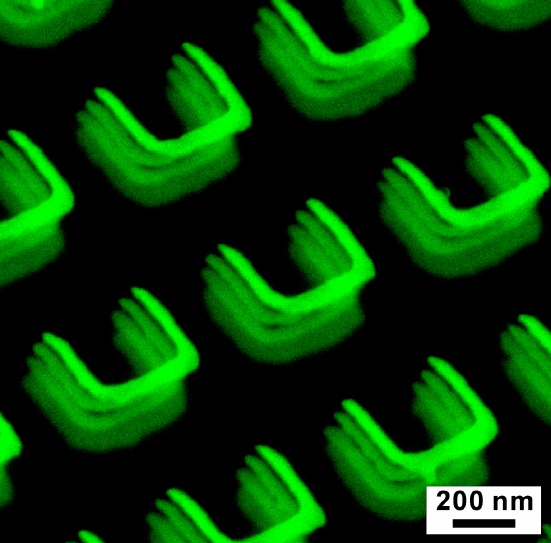Metamaterials have been the darling of materials science in the last decade. Initially metamaterials could achieve a certain amount of invisibility but only in the microwave range - none of us can see microwaves, of course, but then in 2007 it became possible to attain invisibility in the optical range, though at a small scale. Optical invisibility works because metamaterials have a negative index of refraction - and index of refraction is a measure of how much the speed of light changes when it enters that material, with a vacuum being 1 and something like water being 1.3. For metamaterials to work, they have to be manipulated at dimensions smaller than the wavelength of the incident light, so not much use for you and me just yet.

3D metamaterials. Gold nano split ring resonators are stacked (Universität Stuttgart/ MPI)
Researchers in Spain took invisibility researcher a step in a different direction with acoustic invisibility, which would have applications mostly for military stealth, using metamaterials made of sonic crystals.
Like its visibility counterpart, acoustic cloaking has a narrow frequency range where it will work. Leave it to mathematicians to tackle earthquakes - at least numerically.
"We have shown that it is numerically possible to cloak objects of any shape that lie outside the cloaking devices, not just from single-frequency waves, but from actual pulses generated by a multi-frequency source," said Graeme Milton, distinguished professor of mathematics at the University of Utah.
Their 'active cloaking' technique would not use metamaterials and a passive approach but instead employ electromagnetic fields. How well? Radar microwaves have wavelengths of about four inches and Milton said their study last year in Physical Review Letters showed it was possible to use their method to cloak something 10 times wider, or 40 inches, at least from radar.
The obstacle for invisibility using this technique is that visible light has tiny wavelengths and no one wants to make all those tiny antennas, so if it ever happens metamaterials are more likely to be the roadmap. The obstacle for physical invisibility is that you have to know everything about a seismic wave, in the case of an earthquake, or a water wave in the case of a tsunami, including when the pulse begins and also the frequencies and amplitudes of the waves within the pulse.
But that is an issue of having lots of sensors and not a science issue. Since the wavelengths are much larger than visible light an 'earthquake cloak' is a lot more feasible in the short term.
What is even more feasible in the short term are plastic concentric rings of plastic fitted to the Earth’s surface that could divert surface waves. By manipulating the elasticity and stiffness of the rings, waves that reach the ‘cloak’ are compressed into small fluctuations in pressure and density and the path of the surface waves can be made into an arc that directs the waves outside the protective cloak. Sebastien Guenneau and Sasha Movchan at the University of Liverpool, and Michele Brunhe from Cagliari University say their technique could be applied to buildings by installing the rings into foundations.
A little too late for the recent earthquake disaster in Haiti but much cheaper than rebuilding cities from the ground up.
REFERENCES:
Farhat et al. Ultrabroadband Elastic Cloaking in Thin Plates. Physical Review Letters, 2009; 103 (2): 024301 DOI: 10.1103/PhysRevLett.103.024301
Brun et al. Achieving control of in-plane elastic waves. Applied Physics Letters, 2009; 94 (6): 061903 DOI: 10.1063/1.3068491





Comments